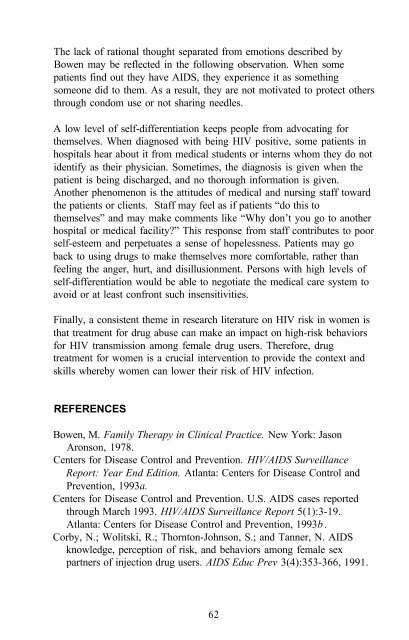The Context of HIV Risk Among Drug Users and Their Sexual Partners
The Context of HIV Risk Among Drug Users and Their Sexual Partners
The Context of HIV Risk Among Drug Users and Their Sexual Partners
Create successful ePaper yourself
Turn your PDF publications into a flip-book with our unique Google optimized e-Paper software.
<strong>The</strong> lack <strong>of</strong> rational thought separated from emotions described by<br />
Bowen may be reflected in the following observation. When some<br />
patients find out they have AIDS, they experience it as something<br />
someone did to them. As a result, they are not motivated to protect others<br />
through condom use or not sharing needles.<br />
A low level <strong>of</strong> self-differentiation keeps people from advocating for<br />
themselves. When diagnosed with being <strong>HIV</strong> positive, some patients in<br />
hospitals hear about it from medical students or interns whom they do not<br />
identify as their physician. Sometimes, the diagnosis is given when the<br />
patient is being discharged, <strong>and</strong> no thorough information is given.<br />
Another phenomenon is the attitudes <strong>of</strong> medical <strong>and</strong> nursing staff toward<br />
the patients or clients. Staff may feel as if patients “do this to<br />
themselves” <strong>and</strong> may make comments like “Why don’t you go to another<br />
hospital or medical facility?” This response from staff contributes to poor<br />
self-esteem <strong>and</strong> perpetuates a sense <strong>of</strong> hopelessness. Patients may go<br />
back to using drugs to make themselves more comfortable, rather than<br />
feeling the anger, hurt, <strong>and</strong> disillusionment. Persons with high levels <strong>of</strong><br />
self-differentiation would be able to negotiate the medical care system to<br />
avoid or at least confront such insensitivities.<br />
Finally, a consistent theme in research literature on <strong>HIV</strong> risk in women is<br />
that treatment for drug abuse can make an impact on high-risk behaviors<br />
for <strong>HIV</strong> transmission among female drug users. <strong>The</strong>refore, drug<br />
treatment for women is a crucial intervention to provide the context <strong>and</strong><br />
skills whereby women can lower their risk <strong>of</strong> <strong>HIV</strong> infection.<br />
REFERENCES<br />
Bowen, M. Family <strong>The</strong>rapy in Clinical Practice. New York: Jason<br />
Aronson, 1978.<br />
Centers for Disease Control <strong>and</strong> Prevention. <strong>HIV</strong>/AIDS Surveillance<br />
Report: Year End Edition. Atlanta: Centers for Disease Control <strong>and</strong><br />
Prevention, 1993a.<br />
Centers for Disease Control <strong>and</strong> Prevention. U.S. AIDS cases reported<br />
through March 1993. <strong>HIV</strong>/AIDS Surveillance Report 5(1):3-19.<br />
Atlanta: Centers for Disease Control <strong>and</strong> Prevention, 1993b.<br />
Corby, N.; Wolitski, R.; Thornton-Johnson, S.; <strong>and</strong> Tanner, N. AIDS<br />
knowledge, perception <strong>of</strong> risk, <strong>and</strong> behaviors among female sex<br />
partners <strong>of</strong> injection drug users. AIDS Educ Prev 3(4):353-366, 1991.<br />
62
















